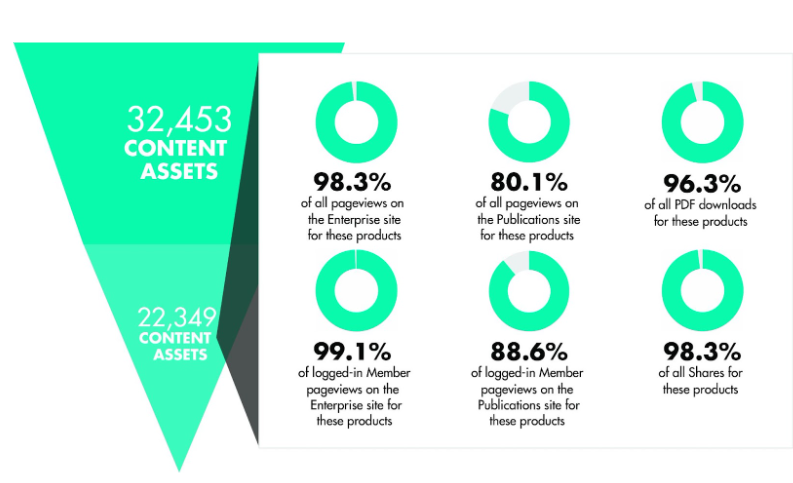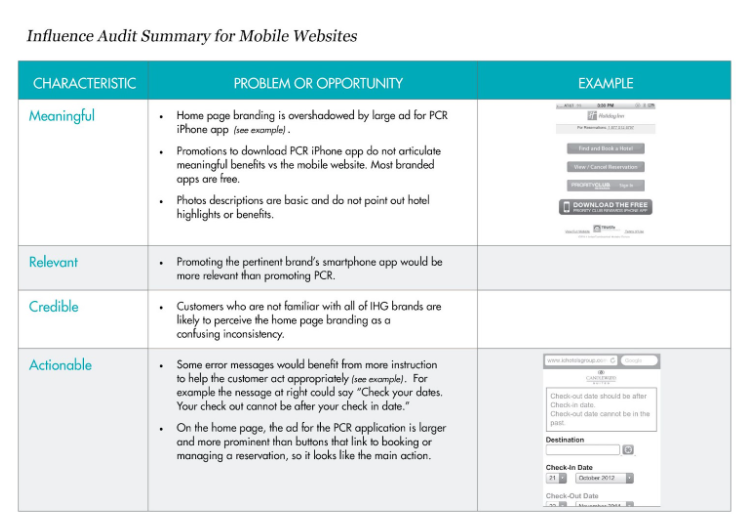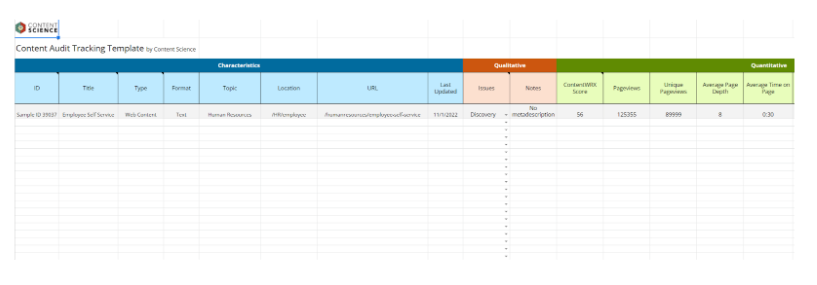
Conducting a content audit is an essential part of any successful content analysis. It does require time and effort. As Colleen Jones notes in The Content Advantage:
“I have conducted or overseen hundreds of content analysis efforts. If you have not analyzed your content, customers, or context recently, then expect the effort to take one to three weeks, at least. For large and enterprise companies, expect at least four weeks.”
But the results of a content audit are very worthwhile. This guide explains what a content audit is, when it’s useful, and how to start conducting your own.
What Is a Content Audit?
A content audit is a comprehensive review of the existing content on your website or digital experience. Content includes pages, images, documents, videos, components, and more. You also might include source material, such as books, brochures, or other material that could be a useful starting point for content on your website and other touchpoints.
A content audit tells you what content currently exists, how it performs, how it measures up to quality and effectiveness standards, and more. These insights help you in many ways, such as:
- Deciding what content to keep, update, or delete.
- Informing content migration plans.
- Revealing opportunities to consolidate and reuse content.
- Determining changes needed to content creation, operations, and governance.
When Should I Conduct a Content Audit?
If you are gearing up for a website or product redesign or are undertaking a new content strategy, doing a content audit is a key first step. You need to take time to understand what content you have and how it aligns with your new direction.
Additionally, you’ll want to monitor your content through regular audits. How often you conduct a content audit will depend on many factors, such as the size of your website or digital experience, as well as how often you publish new content and how quickly your business or industry changes. For most organizations, conducting a content audit once a year is enough. However, if you are making big changes to your website or digital experience or publishing a lot of new content, you may want to do audits more often.
How To Perform a Content Audit
Typically, a content audit involves four key steps.
- Determining your goals.
- Creating a content inventory.
- Auditing the content quantitatively.
- Auditing the content qualitatively.
Let’s take a closer look at each of these steps.
1. Determining Your Goals
When you set out to conduct a content audit, the first step is to determine your goals. What exactly are you hoping to achieve by auditing your content?
- Are you looking to improve your website’s search engine optimization (SEO)?
- Are you trying to get a better sense of what kind of content is resonating with your audience?
- Do you want to identify and eliminate any outdated or irrelevant content?
Answering these questions will help you focus your efforts and make sure that your content audit is a success. Once you know what you’re trying to accomplish, you can move on to creating a content inventory.
2. Creating a Content Inventory
The next step in a content audit is to create a content inventory. This inventory includes a list and description of all the content assets on your website or digital experience. These assets can include pages, images, documents, videos, components, and more. In some cases, you may be able to export the inventory from your content management system (CMS). However, for large sites or digital experiences, you may need to assemble the inventory from multiple sources, including a spidering tool, reports from your CMS and analytics platform, and manual review.
You can assemble the inventory in a spreadsheet and track key characteristics of the content, including, but not limited to:
- Format (such as image or video) or type (such as article or report).
- Topic covered.
- Size.
- Length, such as character counts.
- Metadata, such as titles and tags, currently associated with the assets.
Simply completing this inventory is a valuable exercise for most companies to understand the scope and characteristics of their content. Also consider developing a report or dashboard that summarizes your insights
Tip: Be sure there’s a unique identifier on each piece of content. There should be a content ID if using a CMS. If not, you may need to create a system of identifying each asset.
3. Auditing the Content Quantitatively
Once you have an inventory of your content, you can begin to audit the content quantitatively. A quantitative audit looks at performance data to understand how the content is performing.
It can include:
- Pageviews.
- Average time on page.
- Link clicks ideo views.
Common sources of quantitative data include, but are not limited to:
- Analytics tool.
- Content management systems.
- Social media channels and tools.
By the end of a performance audit, you will likely have a rather complex spreadsheet that is incredibly useful but not something many stakeholders and executives will review in detail. So consider developing a report or dashboard summarizing the quantitative audit insights. For example, the figure below shows a dashboard that highlights that a small percentage of the content is driving the performance, revealing a number of opportunities to streamline the content.

A quantitative audit can give you valuable insight into what content you have and how it’s performing. Now, let’s turn to the qualitative step.
4. Auditing the Content Qualitatively
A qualitative audit looks at your content through a qualitative lens, such as how well the content reflects brand voice or adheres to Google quality standards. This step provides more context for the quantitative audit.
- Select an appropriate sample or subset of content, which makes the task more manageable.
- Then choose your review criteria.
- Next, review the sample.
- Then you can identify areas for additional review.
- Lastly, summarize and share your insights .
Wondering how to select the right sample? If you’re dealing with a large set of content, you can gain a tremendous amount of insight about the set by reviewing a sample. Select a representative sample to review. We recommend a 20% sample that cuts across common examples and critical examples (such as content that supports sales for a priority product or service). This sampling rationale is not only intuitive but also grounded in science—specifically, qualitative research methodology.
Your quantitative performance audit can inform your sampling choices. For example, you might want to investigate extremely high-performing content to identify potential reasons for its success. You also might want to review extremely low-performing content to understand its potential for improvement or to confirm that it should be deleted or archived.
While the notes for your audit might take form in a spreadsheet, it’s also important to summarize and share them. This example shows the top opportunities identified from a qualitative audit.

Types of Tools To Aid Content Audits
Many tools are now available to aid you in a content audit. We’re noting a few types of tools here. You can learn more about content tools and technology. from our [name and link to fact sheet and / or guide].
- Crawler Tools
Crawler tools assemble content inventories and, often, search engine optimization (SEO) and technical details. For instance, Screaming Frog SEO Spider is a paid tool that can find and identify problems with content. It can find broken links, duplicate content, and other issues that can impact your SEO. MarketMuse is another tool that can help you automate parts of your content inventory creation.
- Website and Channel Analytics Tools
Analytics are important to understanding content performance, and a range of tools are available to help. For example, Google Analytics is a free or paid tool that can track traffic to your website. It can also measure the performance of your content, including the number of page views and unique visitors. ContentWRX is another analytics tool that can track specific types of data, such as microengagements.
- Standards Auditing Tools
To gain more understanding into how well your content adheres to important standards for SEO, accessibility, plain language, and more, a variety of tools such as SiteImprove and Acrolinx can help. HubSpot Website Grader is a free tool that provides an in-depth analysis of your website.
- Content Effectiveness Tools
If you want to get a handle on how effective your content is, tools such as ContentWRX and Parse.ly can be very insightful. ContentWRX gives your content an overall effectiveness score and details ways to improve your content across six key dimensions:
- Discovery
- Accuracy
- Polish
- Relevance
- Usefulness
- Influence
Parse.ly software helps you optimize your content across a variety of platforms and provides data around how to increase readership and engage your audience.
Content Audit Template
A content audit template can be a helpful tool for conducting your audit. Use a template to track the pages on your website, their associated metadata, and any notes you have about each page.
The template can also include columns for sorting the pages into categories. As you go through your pages, add notes about each page in the template. Your notes will help you keep track of which pages are outdated or no longer relevant.
Our content audit template is designed to help you track all your content, including the content ID, title, type, location, URL, status, and more. With our template, you’ll be able to see at a glance what content is performing well and where you might need to make some changes.

Download our Audit Tracking Template.
Moving Forward With Content Audits
Now that you have a good feel for how to start a content audit, you’re ready to take the next steps. Here are some suggestions for how to go from idea to implementation with help from Content Science:
Dig in deeper with a certification course: This article features content from Content Science’s Content Strategy + Analysis Certification program, which is part of our Content Science Academy. The certification course goes in depth into content auditing, user journeys (that work for content), content analytics, and competitive content analysis—and provides examples, practice assignments, and tools to get you going.
Get guidance from The Content Advantage: There are even more content audit insights and examples in The Content Advantage. You can use the information in the book to help you interpret and act on your content audit as you go.
Partner with Content Science: We’re here to help you. If your organization is ready to get to work, engage Content Science to conduct an in-depth, large-scale analysis efficiently and effectively.
A content audit tells you what content currently exists, how it performs, how it measures up to quality and effectiveness standards, and more.
-
Events, Resources, + More
The Ultimate Guide to End-to-End Content
Discover why + how an end-to-end approach is critical in the age of AI with this comprehensive white paper.
The Content Advantage Book
The much-anticipated third edition of the highly rated book by Colleen Jones is available at book retailers worldwide. Learn more!
20 Signs of a Content Problem in a High-Stakes Initiative
Use this white paper to diagnose the problem so you can achieve the right solution faster.
Upskill with Content Science Academy
Training for modern content roles through on-demand certifications + courses or live workshops.






Comments
We invite you to share your perspective in a constructive way. To comment, please sign in or register. Our moderating team will review all comments and may edit them for clarity. Our team also may delete comments that are off-topic or disrespectful. All postings become the property of
Content Science Review.